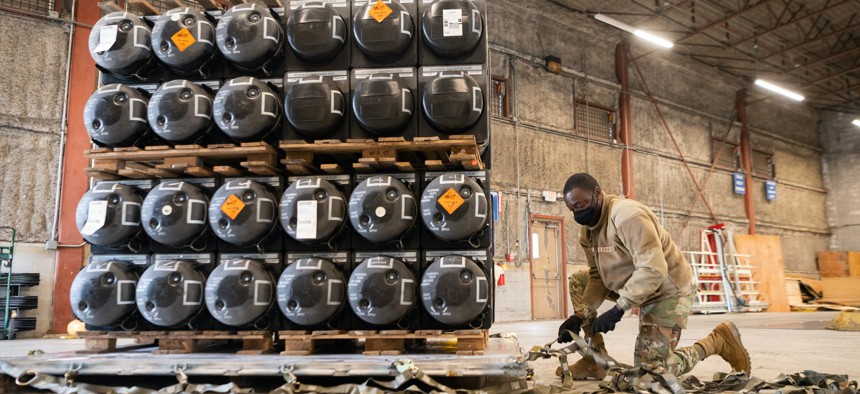
Airman 1st Class Olabode Igandan palletizes ammunition, weapons, and other equipment bound for Ukraine at Dover Air Force Base, Delaware, Jan. 21, 2022. U.S. Air Force / Mauricio Campino
Pentagon Puts 8,500 Troops On ‘Heightened Alert’ Over Russian Threat To Ukraine
The force would not seek to stop an invasion, but to protect NATO’s Eastern flank.
Updated: 7:23 p.m. ET to add information about Marines.
Defense Secretary Lloyd Austin ordered about 8,500 U.S.-based troops on heightened alert Monday to be ready to deploy to Europe and support NATO if Russia invades Ukraine.
Some of those units—which include logistics, medical, transportation, and intelligence and surveillance support elements—could join a multinational NATO response force of about 40,000 troops. Other U.S. forces already in Europe could be sent to NATO’s eastern flank: Estonia, Lithuania, Latvia, and Poland.
“At the direction of the President and following recommendations made by Secretary Austin, the United States has taken steps to heighten the readiness of its forces at home and abroad. So they are prepared to respond to a range of contingencies, including support to the NATO Response Force if it is activated,” Pentagon press secretary John Kirby said Monday.”
The call-up occurs one day after the State Department ordered all family members of U.S. diplomatic staff to leave Ukraine, citing increased indications that Russia may invade. The U.S. is sending pallets of weapons and ammunition to Ukraine to help those forces defend themselves.
Russia has amassed more than 100,000 troops along the Ukrainian border and has been conducting large military exercises in Belarus.
“It’s very clear that the Russians have no intention right now of de-escalating,” Kirby said.
He said no decision has been made to deploy the forces that are now on alert, nor where in Europe they might go.
“This is about placing units on a heightened alert,” Kirby said. “It does not mean they are going to be jumping on gray tails and leaving” right away, he said, referring to the Air Force’s airlift capabilities of forces and equipment.
The call-up builds on other Western responses to the Russian moves. Last week, the Pentagon announced that the Truman carrier strike group would be conducting large-scale naval exercises in the Mediterranean. On Monday, NATO officials said the strike group was operating under alliance command, a post-Cold War first. The United Kingdom has flown anti-tank weapons into Ukraine as well.
The U.S. already has some forces in Ukraine. For example, elements of the Florida National Guard are currently deployed there as part of a regular rotational force that trains and equips Ukrainian forces.
No Marines are among the 8,500 U.S.-based troops on heightened alert, a senior Marine Corps official said Monday.
If additional U.S. forces are needed to support NATO missions, the official said, about 5,000 Marines who will be participating in Norway’s upcoming Cold Response 22 exercise could be called upon.
“What we've told the joint force is, if it would be useful, we could deploy that force faster if needed. And we've offered that formation to be included in any force offerings that the joint force feels NATO needs to be positioned better vis-a-vis the current situation in the Ukraine,” he said.
Marines have been in Norway for about five years as part of rotational deployments to participate in exercises. American equipment is stored in Norway, allowing the U.S. to quickly deploy a large number of forces who can then retrieve the equipment and be operational, the official said.
Caitlin Kenney contributed to this report.





